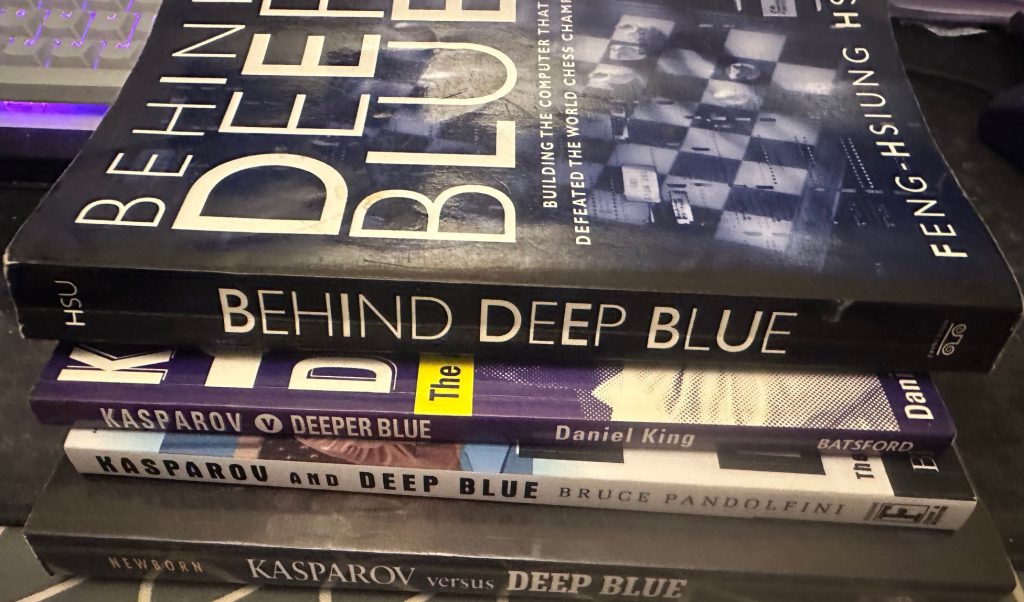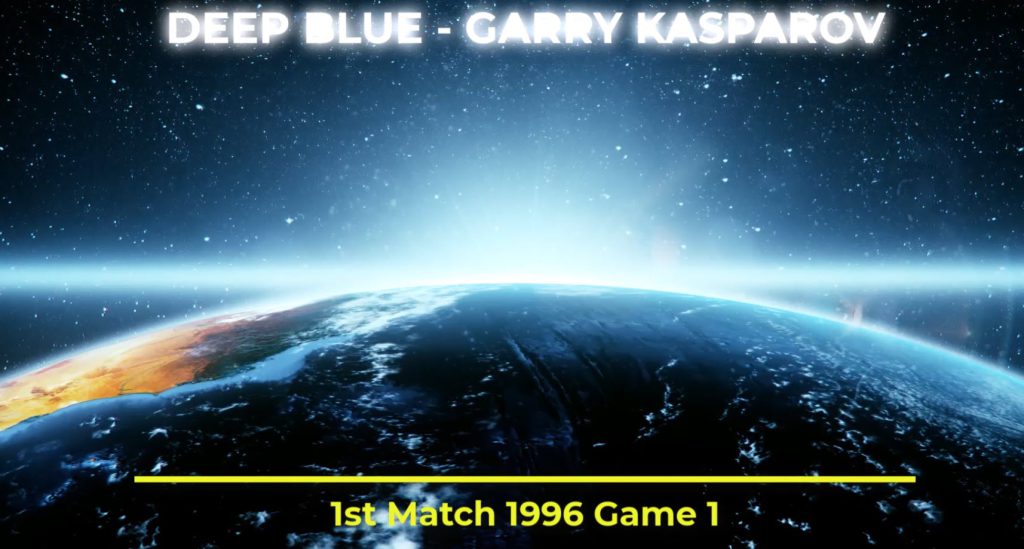The idea for a series of videos on the Garry Kasparov against Deep Blue matches of 1996 and 1997 came from a subscriber to my YouTube channel. I thought it was a great idea and I’ve become a bit obsessed with it! The videos are on my Silicon Road YouTube channel which is here: https://www.youtube.com/@SiliconRoadChess in a special Playlist called “Deep Blue Rediscovered” and the videos will be coming out over the next few weeks, starting with the 1996 match. All 7 videos of the 1996 match are available here:
Introduction to the series and the 1996 match: https://youtu.be/GIV1E783EK0
1996 match, Game 1: https://youtu.be/i2PRgmgOQ4s
1996 match, Game 2: https://youtu.be/YkdWvh80A_c
1996 match, Game 3: https://youtu.be/xEY8fjTh0vI
1996 match, Game 4: https://youtu.be/-gVYElKzKms
1996 match, Game 5: https://youtu.be/2goMldCAJzc
1996 match, Game 6: https://youtu.be/-cnJ7Ssls0Y
I’ve been going through all the games with modern engines like Stockfish, Leela and Dragon 3.3 and finding a lot of new insights. It’s been fun – and also a little weird – to look at this pivotal moment in chess history and chess engine history with the current perspective of knowing that engines would become way stronger than humans! It’s a little bit different to how people were looking at things at the time! As well as the engine matches I’ve run, I’ll draw on a lot of contemporary sources which I’ll introduce in the next few paragraphs.
The sources
Behind Deep Blue by Feng-hsiung Hsu (https://www.amazon.co.uk/Behind-Deep-Blue-Building-Computer/dp/0691118183) Feng-hsiung Hsu was the “father” of Deep Blue. It’s a fascinating book published in 2004 with a lot of inside information about what the Deep Blue team was up to!
In a similar vein there’s two very nice scientific papers by Murray Campbell who was also there pretty much from the start. “Deep Blue” (Murray Campbell, A.Joseph Hoane Jr, Feng-hsiung Hsu) https://doi.org/10.1016/S0004-3702(01)00129-1 is an interesting general paper about Deep Blue and “Knowledge Discovery in Deep Blue” (Murray Campbell) https://dl.acm.org/doi/pdf/10.1145/319382.319396 is something quite special, describing the extended opening book which was a key factor in Deep Blue’s success, especially in the 1997 match.
We’ve also got Garry’s perspective in his book “Deep Thinking” (https://www.amazon.co.uk/Deep-Thinking-Machine-Intelligence-Creativity/dp/1473653509) which was published in 2017. As always with Garry there are lot of chess insights and some characteristically Garry comments as well!

For the 1997 match, we have something really nice: Deep Blue’s logs from the games. Feng-hsiung Hsu wrote in “Behind Deep Blue” that those logs were on the Deep Blue match website but that website is long gone. However the Internet Wayback Machine came through and got me the logs anyway! These logs have been looked at before in a series of articles by Albert Silver on Chessbase (https://en.chessbase.com/post/komodo-8-deep-blue-revisited-part-one) but I think what I’m doing here is probably the most intensive examination of these logs so far.
There was a BBC Sounds “Reunion” hosted by Kirsty Wark (https://www.bbc.co.uk/programmes/m001bkvt) which brought together Joel Benjamin, Murray Campbell, Malcolm Pein, Maurice Ashley, and Frederic Friedel. The conversation that ensued between people who were involved in different aspects of the match was very interesting.
There’s also a 2004 film called “Game Over” (Game Over (2004)) which features Garry very heavily. It’s a bit of an odd film but it features lots of contemporary footage which is pretty cool!
Finally, there are some contemporary annotations, especially for the 1997 match. Yasser Seirawan wrote some deep annotations for his own magazine “Inside Chess” which I remembered as being very interesting …and that’s definitely true! I have those still in my parents’ attic, but not being brave enough to go up there, I went for the Chess Café archive instead! (https://chesscafe.com/)
Daniel King, wrote an interesting book (https://www.amazon.co.uk/Kasparov-Deeper-Blue-Daniel-King/dp/B01B992GD4) on the matches (with an interview with Garry after game four of the 1997 match!) He also did a series of videos on his Powerplay channel and as always with Daniel, it was good stuff! (https://www.youtube.com/watch?v=wogG0MAH-1E )
John Nunn also annotated the games from the 1997 match for Chessbase in his usual excellent manner.
My perspective as a chess professional in 1996/1997
I was a chess professional in 1996 and 1997 so what did I make of the match? Although I followed the games and the drama, I never made the extra step of really analysing Deep Blue’s games…and I’ve been trying to understand why on earth I didn’t! I guess the point was that – at a cursory glance – Deep Blue’s play didn’t seem that remarkable. It was very strong but there were many players in the world’s top ten who were also very strong! Moreover, it was running on hardware that – to me at the time – seemed beyond anything I would ever see in my life (how wrong I was!) I think it all felt a bit too far away and beyond my world. But when you start looking at the games, you realise that Deep Blue did a lot of things that that were heralding what was to come! Deep Blue was far from perfect obviously and much weaker than modern engines but there was a lot of quality in its play.
Background
For the 1996 match, the negotiations with Garry started in late 1994, and the match took place in February 1996. You would think that the Deep Blue team had all the time in the world to prepare a great machine. But.. anyone who’s been involved in IT projects knows that it’s never the case! Feng-hsiung Hsu describes a harrowing time to get Deep Blue ready. He had a car accident and some associated health issues and there were many manufacturing problems.
The problem was that he was building a very specific chess chip. It seems weird to us, used to running Stockfish on a general purpose laptop and it’s unbelievably strong, but in those days you needed a dedicated chess chip to stand any chance of matching Garry. They only got their first batch of working chips in December 1995 which was about when Joel Benjamin was brought in as the match second to work on the opening book and also hopefully give Deep Blue some extra insights. Just two weeks before the match, they finally got all the chips that they that they needed (though not as many as they wanted – only 216 instead of 576) The hardware thus came very late and – as always – the software guys had to scramble like anything to make anything of it. As the match started, the Deep Blue guys were truly nervous that it maybe just wouldn’t work at all!
Deep Blue’s speed
Those 216 chess chips could each search 1.6 million positions per second. The maximum Deep Blue search for the 1996 match was theoretically 300 million positions per second, although the highest observed speed was 100 million positions per second. Obviously you’re running these chess chips on multiple computers and you need to coordinate them all so there’s quite a lot of overhead involved. Feng-hsiung Hsu said that if they’d had more time they could have made everything a lot more efficient but they had no time so they just had to go with what they had.
Final observations
I still find it hard to get my head around the idea that a lot of Deep Blue’s chess evaluations were computed directly on the chip. Deep Blue could notice a huge number of positional factors in hardware directly and compute them there. That made Deep Blue way faster than anything else as all the other chess programs were using much slower software for that. But of course there are advantages and disadvantages to Deep Blue’s approach. It’s incredibly fast but if you programmed it wrong in hardware…then it was very hard to change: it’s just locked in, hard-coded. The Deep Blue software was maybe working around some mistakes, but mainly assigning weights to the evaluation factors – this is more important and that’s less important – to help Deep Blue decide on its moves.
One of the most shocking things was how much was happening on the fly. Some fairly major changes to evaluation were being made on the basis of one game against Garry. If you tell the Stockfish guys nowadays “Oh Stockfish did something bad in that game, you need to look at it” they’re always saying “nah, we don’t look at just one. We look at things over thousands, millions of games!”
Anyway, hope that introduction has whetted your appetite, If it has, head over to the Silicon Road YouTube channel and enjoy the fun!




A great thanks to the subscriber who got this idea. Of course, i’ve seen both the first two video’s. But reading the blog with a good cup of coffee is a nice way to start the weekend. Thanks for all the info and links Matthew.
Thanks Marc! 🙂 🙂